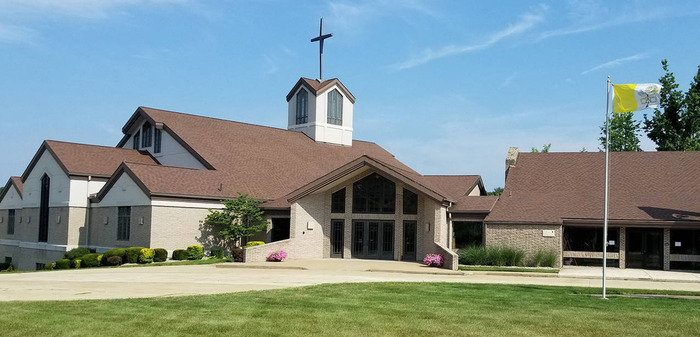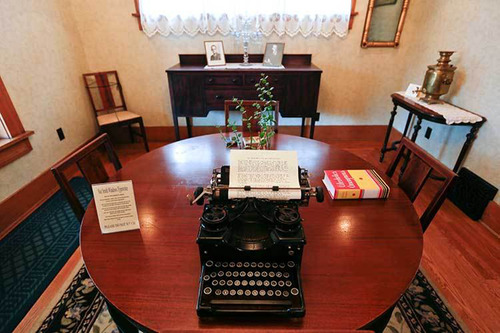
Daytrips can be a bit quirky. How does a trip to the Akron Art Museum include a stop at a Catholic church that curates nativity scenes? And a stop at Bob’s House? Also on the itinerary — Don Drumm Studios & Gallery, which I would soon discover is quite a big deal. Lunch at Lockview Restaurant on Main was long overdue—in our years of Akron Civic Theater concert going, we never quite made it across the street.
The friends I traveled with are seriously Catholic, so I knew not to protest our first stop: Nativity of the Lord Jesus Catholic Church in northern Akron. In a farming community-turned-suburban area with green lawns, we came to a church built in 1979. The docent gave us a tour that highlighted stained-glass windows depicting the mystery of Christmas, the Nativity Museum, the Bethlehem Cave, and the spacious trussed-ceiling sanctuary.
I felt that the church was succumbing to the church-as-museum fate of cathedrals throughout the world. A 16th-century church bell originating from St. Augustine hangs from the cupola, and the church has collected innumerable nativities from every continent except Antarctica. And then there was the Cave, which includes a half-scale replica of the cave where Jesus was born in Bethlehem. If nothing else, it was different, and interesting to see how the holy family is portrayed much differently in Peru than in Germany.
It was a short drive to the Don Drumm Studios & Gallery on Crouse Street. Don Drumm, an award-winning sculptor, master designer and innovator, has enhanced public spaces for 60 years and was educated at Kent State. His work with industrial materials to create wall sculptures and furniture inspired by nature led to the 1971 opening of his gallery.

The gallery comprises two renovated houses whose numerous rooms display and sell ceramics, fiber art, toys, leather, jewelry and glass made by over 500 artists from all over the Americas, including local artists. The gallery is enchanting and inspiring, and it’s considered one of the country’s top contemporary craft retailers. On that first visit, I asked what I should buy, what will work in my home? Who can I gift this to? And there were my typical art-class questions: what was the artist trying to do, how did she do it, what influenced the choice of materials? Despite my out-of-body Zen experience, I settled on some yard art and hope to be better grounded for shopping on my next visit.
The Lockview is a tavern with stone-brick walls and booths that is comfortable and busy, even on a weekday at lunch. Fifteen unique grilled cheese sandwiches rule the menu. Starters ranging from kettle chips and French onion soup to sauerkraut balls are tempting. Homemade macaroni and cheese, fish tacos, sandwiches and other offerings provide lots of options. Food and service were good. Outside, we spied the Akron Civic Theater, built in 1929 and one of only a handful of with an atmospheric star-studded ceiling and moving clouds, on the opposite side of the street.
Our next stop was Dr. Bob’s Home on Ardmore Avenue. Dr. Bob was the founder of Alcoholics Anonymous. The story is that in 1935, Bill Wilson, an alcoholic who’d stopped drinking, met Bob Smith, a surgeon in need of sobriety, and was invited to reside in Dr. Bob’s house. That friendship led to the founding of AA. Dr. Bob’s home became a half-way house where alcoholics were detoxed, and its first members pounded out the principles of AA on the typewriter displayed on the dining room table today.

There was much evidence of Dr. Bob’s struggles, including bottles hidden on a dumbwaiter and in the nooks and crannies of the basement, and a garage where his car was always ready for an escape. Alcoholics now make pilgrimages to the home that has been restored to its 1935 character—the docents make the stories come alive.
We ended the day at the Akron Art Museum. We only had an hour to see the permanent collection and the special exhibit of Keith Haring’s work. It was not enough time. But we got a feel for the scope of the art, which focuses on modern and contemporary art created after 1850 and features regional as well as international artists. Although the museum came into existence in 1924, it didn’t move to its permanent site until 1937 and at the time, it was an art center that displayed work by local artists. When the school closed in 1965, the focus shifted entirely to collection and exhibition of fine art. Like the Cleveland Museum of Art, the Akron Art Museum is housed in a new building adjoined to a historic building — the John S. and James L. Knight Building adjoins an 1899 post office.
I’m thinking about a long day in Akron over the holidays — shopping at Don Drumm’s, Stan Hywet all dolled up in greenery and poinsettias, a stop to see nativities, the Nutcracker performance at the Akron Civic Theater, and a stop to see exhibits at the Akron Art Museum. Now it’s starting to sound like a getaway — we’ll have to look at hotel rooms.